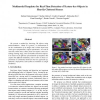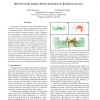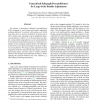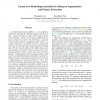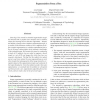125
click to vote
ICCV
2011
IEEE
14 years 1 months ago
2011
IEEE
We present a method for detecting 3D objects using multi-modalities. While it is generic, we demonstrate it on the combination of an image and a dense depth map which give complem...
ICCV
2011
IEEE
14 years 1 months ago
2011
IEEE
In this paper, we present a novel, threshold-free robust estimation framework capable of efficiently fitting models to contaminated data. While RANSAC and its many variants have...
130
click to vote
ICCV
2011
IEEE
14 years 1 months ago
2011
IEEE
We present a generalized subgraph preconditioning (GSP) technique to solve large-scale bundle adjustment problems efficiently. In contrast with previous work which uses either di...
ICCV
2011
IEEE
14 years 1 months ago
2011
IEEE
We propose a novel framework for imposing label ordering constraints in multilabel optimization. In particular, label jumps can be penalized differently depending on the jump dire...
115
click to vote
ICCV
2011
IEEE
14 years 1 months ago
2011
IEEE
Many image retargeting algorithms, despite aesthetically carving images smaller, pay limited attention to image browsing tasks where tiny thumbnails are presented. When applying t...
112
click to vote
ICCV
2011
IEEE
14 years 1 months ago
2011
IEEE
Recognition of motions and activities of objects in videos requires effective representations for analysis and matching of motion trajectories. In this paper, we introduce a new r...
134
click to vote
ICCV
2011
IEEE
14 years 1 months ago
2011
IEEE
Background modelling on tensor field has recently been proposed for foreground detection tasks. Taking into account the Riemannian structure of the tensor manifold, recent resear...
134
click to vote
ICCV
2011
IEEE
14 years 1 months ago
2011
IEEE
Low-Rank Representation (LRR) [16, 17] is an effective method for exploring the multiple subspace structures of data. Usually, the observed data matrix itself is chosen as the dic...
114
Voted
ICCV
2011
IEEE
14 years 1 months ago
2011
IEEE
Drawing a box around an intended segmentation target has become both a popular user interface and a common output for learning-driven detection algorithms. Despite the ubiquity of...
116
Voted
ICCV
2011
IEEE
14 years 1 months ago
2011
IEEE
Many state-of-the-art segmentation algorithms rely on Markov or Conditional Random Field models designed to enforce spatial and global consistency constraints. This is often accom...
